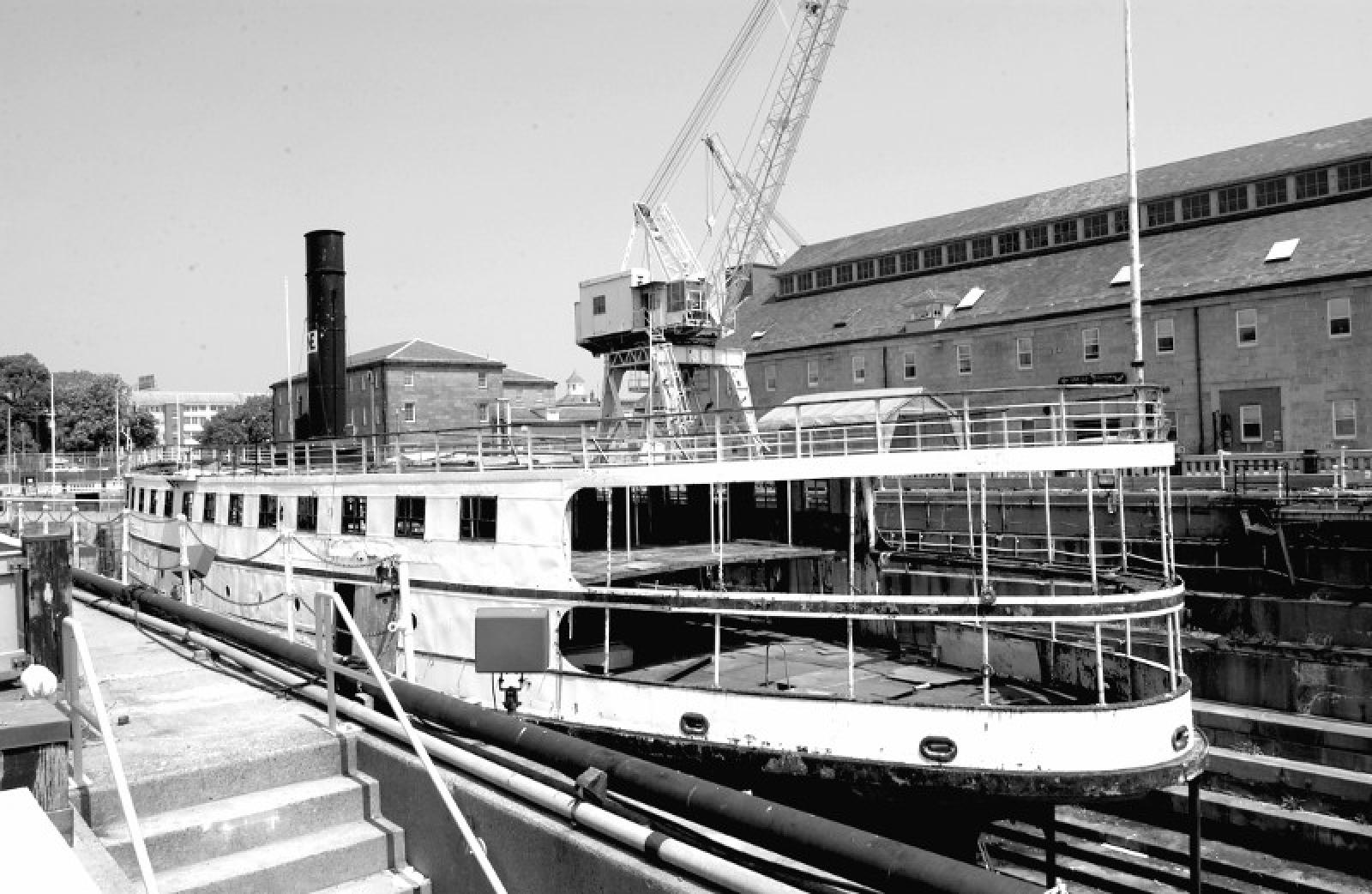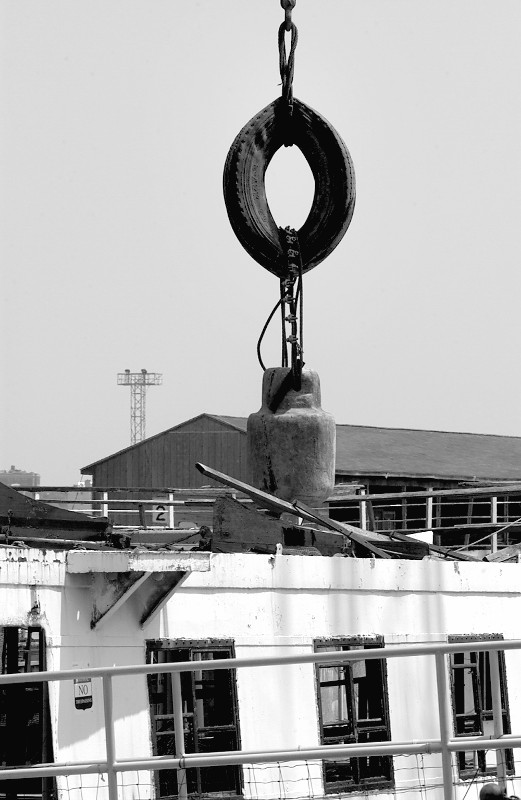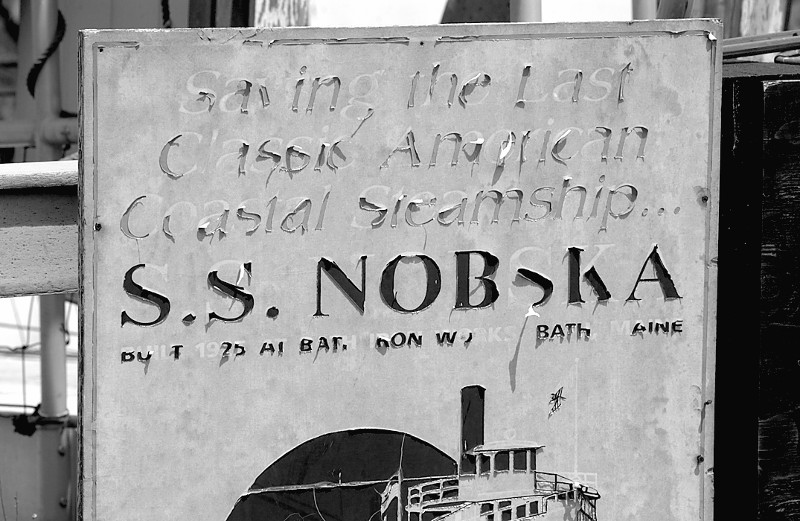Time has finally run out for the Nobska, the last coastal steamer in America and the car and passenger vessel that served the Vineyard between 1925 and 1973. Preliminary work to dismantle the historic vessel began in the Charlestown Navy Yard early this week, and on Wednesday the wrecking ball came down on her upper deck.
Work crews hired by the National Park Service began cutting away her superstructure above the freight deck. The old steamer has been drydocked at the Boston National Historical Park at the Charlestown Navy Yard for the past 10 years.
For more than 30 years a group dedicated to saving the Nobska, the New England Steamship Foundation, has tried to save the ship and possibly return her to passenger service between the Island and the mainland. But the group's efforts to raise the millions needed to save the steamer from the scrap heap have come up far short.
Two other historic ships, the USS Constitution and the USS Cassin Young, need space in the yard's drydock for repairs, and Park Service officials said this week said they had no choice but to get rid of the Nobska.

"Everyone understands that the Nobska is the last remaining coastal steamer in America, and I don't think anyone wants to see her go. But we have to be very careful with whatever little funding comes our way. From a financial and a practical point of view, there is nothing we can do," said David Brouillette, the deputy superintendent of the Boston National Historic Park.
On Wednesday, workers at the Charlestown Navy Yard used a three-and-a-half-ton wrecking ball to tear apart the upper decks of the steamer. The scrapping of the hull is set for early next week.
Although the end is clearly near for the beloved Nobska, some members of the New England Steamship Foundation, a nonprofit group founded as the Friends of Nobska in 1975, are still holding on to a thin thread of hope and claim they have mounted an 11th-hour campaign to raise money to finish work on the hull of the steamer so she can be floated out of the navy yard.
Foundation president Warren R. Hartwell said he is confident people will open their hearts and wallets to save the hull.
"We're not giving up yet. We still have some time left to preserve a vital part of nautical history," Mr. Hartwell said.
More than three million dollars in federal money has already been spent on the vessel. Many new frames have been installed, and all the Nobska's hull plates have been replaced. But before the Nobska can float, she would still need more than 5,000 feet of seam welding between the new plates.
Mr. Hartwell said the foundation has at least a week to raise about $800,000. The foundation already has the steamer's engine and several other internal components, and plans to use them in a historical exhibit in the future.
But Mr. Brouillette said he doubts that $800,000 is enough to save the Nobska. Previous estimates put the cost of rebuilding and restoring the steamer closer to $20 million, and even that might not be enough, he said.
"We've waited long enough. Sadly, it's time to move on," Mr. Brouillette said.
It has been a sad and tawdry final chapter for the Nobska, which served New Bedford, Woods Hole, the Vineyard and Nantucket for almost 50 years. Where once the ship was the queen of the Sounds, in recent years the foundation's efforts to save it have been rocked by legal battles, a fundraising scandal and the removal of its president.
The foundation has even turned to selling one of Nobska's lifeboats over the on-line auction web site e-Bay. The starting bid on the lifeboat is listed at $3,000. Mr. Hartwell said the money from the sale of the lifeboat will go to pay legal costs.
Last April, a controversy over fundraising practices shook the foundation. The scandal centered around an Atlanta-based fundraiser who allegedly used the foundation's letterhead to solicit money from businesses, but the money never made its way back to the foundation.
When she made her maiden voyage in 1925, the Nobska was state of the art. She measured 210 feet in length, carried 25 automobiles and boasted modern safety features, including a sprinkler system.
Her two Babcock and Wilcox watertube boilers furnished steam at 200 pounds of pressure to her four-cylinder triple-expansion steam engine, and she cruised at the impressive speed of 14 knots. She embodied style, grace and modern technology, and was an immediate hit with the Islanders she served.
But with the coming of the interstate highway system, the Nobska grew outdated. New diesel-powered boats were introduced that were faster, more efficient and could carry more automobiles and passengers. The Nobska's three sister ships, all built in the 1920s, were retired or sold. But the Nobska remained dependable, and on at least one occasion proved that she still plenty of steam left in her boilers.
In February 1961 she left her winter berth at New Bedford to make a special weekend trip to Nantucket, which had been without service due to ice in the Sound and in the harbor. The Nobska's sharp bow was better suited to ice breaking then other ferries, and she made the trip successfully, taking several hours more than usual. The story goes that she had freight piled everywhere; some even had been carried up to the saloon deck. Although she was frozen there for the weekend, she was able to return to the mainland for her winter rest on Monday.
Eventually, the Nobska became one of the last coastal steamers in America. After 1965 she normally ran only in summer and on some holidays when traffic was heaviest. By this time, most of the fleet was made up of diesel powered end-loaders, which were more efficient. In the summer of 1973, the Steamship Authority inaugurated service between Hyannis and Nantucket, leaving Nobska as the only passenger vessel on the Woods Hole-Oak Bluffs-Nantucket run.
The Nobska made her last trip to the Islands in September 1973 before being laid up at Vineyard Haven and Nantucket. In May of 1974, the steamer was listed on the National Register of Historic Places, largely due to the efforts of Joseph Morin, a Nantucket terminal employee. The Nobska was sold by the Steamship Authority in June of 1975 to become a restaurant in Baltimore, Md.
The vessel was stripped of all furnishings and equipment except her main engine. The new restaurant opened but soon failed, and the Nobska sat derelict in Baltimore for several years.
In 1988 the Friends of Nobska were able to acquire her and return her to New England, where she was tied up at Fall River, Providence, and New Bedford, with volunteers keeping her pumped out and doing basic maintenance. Meanwhile, the Friends of Nobska renamed itself the New England Steamship Foundation.
The Nobska spent four years in Providence. After the steamer was moved to New Bedford, the foundation tried to secure a license to run a restored Nobska as a passenger steamer and working museum on her original route between New Bedford and the Vineyard. In 1995, the vessel was towed from New Bedford by tugboat to the Charlestown Navy Yard where she sits today - or at least what is left of her.
At times over the next 10 years, the foundation seemed to gain support, but was unable to raise more than a fraction of the many millions still needed to rebuild the vessel.
Earlier this week, with the steamer's chances of floating again virtually gone, Islanders shared fond remembrances of their beloved Nobska.
"I can remember even in the 1960s when I was just a little boy thinking that I had never seen a ship that looked anything like the Nobska," said Tom Dunlop, the managing editor of the Martha's Vineyard Magazine who has written extensively about the old steamer.
Mr. Dunlop said he always marveled at how quiet her engine was and how the steamer - her machinery lubricated with grease - always smelled like breakfast. But most of all, he remembered the sense of adventure he always felt when she pulled away from her wharf.
"When you boarded her you got this sense that you were going on a voyage, that you were going on an adventure to an island," he said.
Mr. Dunlop noted the difference in the experience of traveling on a modern ferry.
"Now, the modern ferry serves as a movable bridge or a tunnel that allows you to easily bring your life from the mainland to the Island. But when you boarded the Nobska you knew that you were leaving one world and entering another," he said.









Comments (8)
Comments
Comment policy »